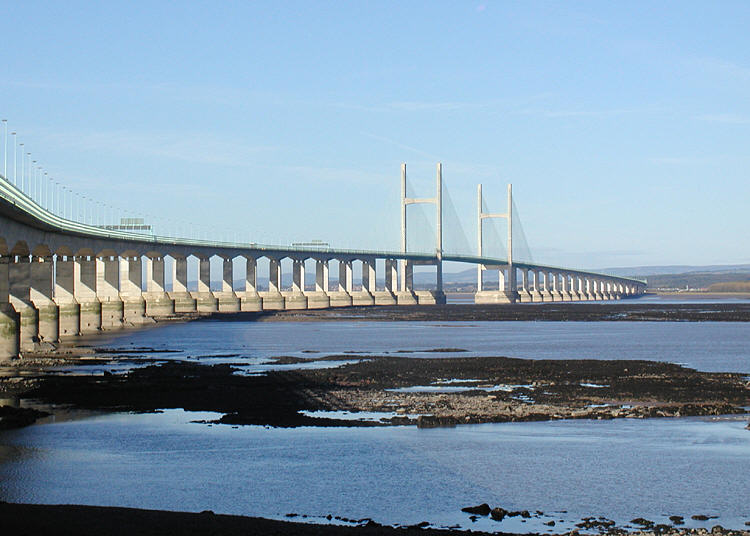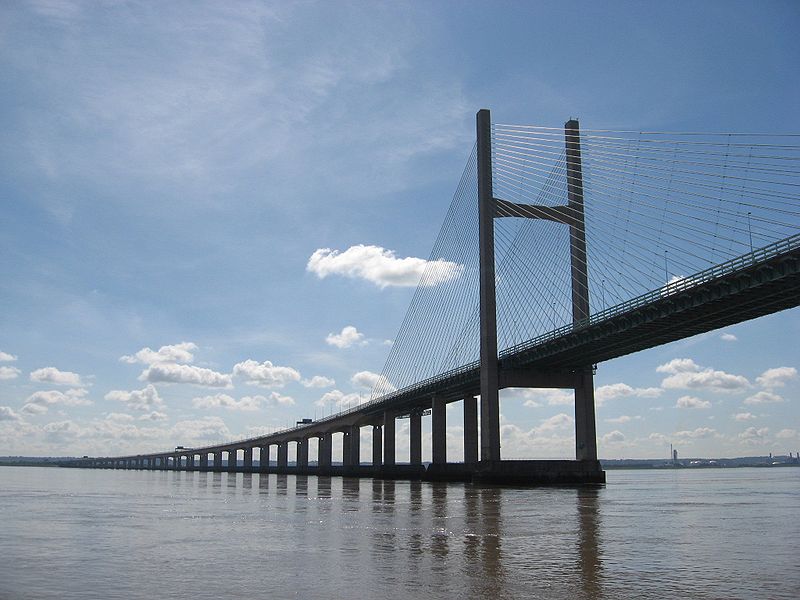| |||||||
Europe
North AmericaSouth AmericaAsiaAustralia and OceaniaAfrica |
Смотрите также: Second Severn Crossing The Second Severn Crossing (Welsh: Ail Groesfan Hafren) is a bridge which carries the M4 motorway over the River Severn between England and Wales, inaugurated on 5 June 1996 by Charles, Prince of Wales to augment the traffic capacity of the original Severn Bridge built in 1966. The bridge marks the lower limit of the River Severn and the start of the Severn Estuary.
Second Severn Crossing Crosses River Severn Locale South West England/South East Wales Design central span: Cable-stayed bridge approach viaducts: Segmental bridge Total length 5,128 metres (3.19 mi) Longest span 456 metres (1,496 ft) Opening date 5 June 1996
Its location is further to the south than the old bridge and being more in line with the landward sides of the M4 motorway, is a shorter journey when travelling between England and South Wales. The junctions at each end are designed for most traffic to use this crossing – to use the old Severn Bridge crossing one has to leave the M4 and join the M48 motorway either at Aust or near Magor. The new crossing carries more traffic than the Severn Bridge, which is still in use. It is wider than the Severn Bridge, having three lanes and hard shoulder each way, compared to the two lanes, cycle path and footpath of the original crossing. The path taken by the bridge is close to that of the Severn Tunnel which has carried the railway line beneath the river since 1886. On 6 February 2009 the bridge was closed by weather for the first time since its opening after three vehicles were struck by falling ice, damaging windscreens. Design The crossing is 3.186 miles (5.127 km) miles long, consisting of a single central navigation span over the "Shoots" channel and approach viaducts on either side. The Shoots channel is the deepest section along the width of the Severn estuary, and a longer span was required to ease the passage of shipping under this section. The central bridge section, called the Shoots Bridge, is of cable-stayed design and the central span (between the bridge pylons) is 456 m (1,500 ft) in length. The approach viaducts are of a segmental bridge design. Its Welsh end is near Sudbrook, Monmouthshire and its English end at Severn Beach in South Gloucestershire. The crossing forms a gentle S shape and near the English side crosses over the top of the Severn railway tunnel. The sides of the bridge are fitted with special railings to reduce lateral wind loads coming from the Severn estuary onto the traffic and this has reduced the number of times that speed restrictions have been needed. The overall design of the new crossing makes it more resistant to high winds than the old Severn Bridge
Construction The crossing was built by a business consortium under a Public-private partnership. A company called Severn River Crossing Plc, led by John Laing plc and GTM-Entrepose, was formed to build the new crossing. The company also took over the responsibility of managing and maintaining the old Severn Bridge crossing, as well as managing and maintaining the new crossing. The cost of constructing the new crossing was expected to be paid for by tolls collected from motorists using the two crossings. Work on the new crossing began in 1992 with completion in 1996. Sub-assemblies for the bridge were constructed onshore and then shifted by a large tracked vehicle (similar to that used to move the Apollo and Space Shuttle at Cape Kennedy) onto a barge, prior to being floated out on the high tide to the appropriate site. The 37 bridge pier foundations on the approach viaducts are 98.11 metres (321.9 ft) apart, and consist of concrete pneumatic caissons weighing 37 tonnes, which were sunk into the mud of the estuary. The decking consists of 3.5 metres (11.5 ft) post stressed match cast sections, weighing 200 tonnes each. The cable stayed section of the crossing is over 900 metres (2,953 ft) long, consisting of a 35 metres (115 ft) wide deck made from steel plate girders with a composite reinforced concrete slab. These were prefabricated on shore and put in place using balanced cantilever methods. There are two 149 metres (489 ft) high twin leg, reinforced and pre-stressed concrete pylons carrying 240 cables which support the bridge deck. Cable vibrations were experienced during construction and secondary cables were added to eliminate this. To avoid detracting from the aesthetics of the primary cables, the secondary cables are very slender and are not very noticeable. Comments: 0 |
|
|||||









































